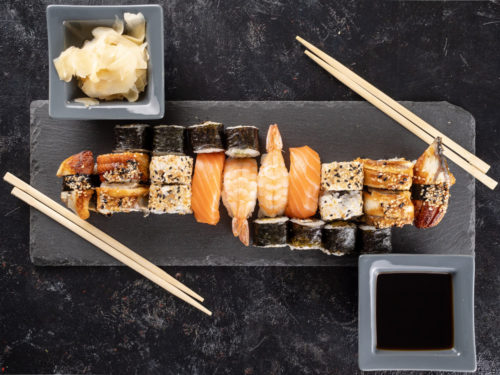Do you love sushi? Why not make sushi at home? It’s not as hard as it may seem, and more so, you define the quality. But do remember! Sushi is not a mere mixture of rice and fish; making them is an exciting cooking act that will not fade once you’ve tried it out. Here you can find how to start with simpler recipes and get to more complicated ones. Starting with sashimi, the easiest of the kind, we will then move to sushi, or sushi rolls, as we may hear in Europe and the USA. We’ll have a look at each of them, maki, and uramaki. Of course, we won’t forget about nigiri. Feel hungry yet?
Sashimi is one of the most popular Japanese meals. These are thin, almost transparent, slices of different kinds of fish or seafood, which are normally served on a bed of vegetables. You may be interested, what is it to cook hear? It’s important to remember that sashimi reflects the philosophy of Japanese cuisine itself. In it, the cook’s ability to combine different ingredients interestingly is the most distinguishable characteristic of her or his mastery. Sashimi is always laid on a plate or a tray in 3, 5, or 7 pieces. It doesn’t serve to satisfy hunger, but to appreciate its taste. It’s an overture, so to say, for the following dishes. You may choose carrots, daikon, seaweed, lemon, pickled ginger, wasabi, or zucchini additionally to the meal itself. It is better to choose seasonal ones, depending on the time you’re going to cook. Grid or cut them into very thin slices, and serve in small heaps.
Nigiri is the next easiest sushi meal we’re going to look at, for this, we will need rice and it’s better to start with it.
- Having washed and dried it naturally, you should cook it in a pot or a rice cooker. Once boiled, leave it on a half intense fire for some more minutes closed. In 10-12 minutes take it off the cooker and lay it out on a towel so it can get cooled for ten more minutes.
- Meanwhile, mix vinegar, sugar, and salt and cook this on low heat until both sugar and salt melt. Depending on your taste preferences, you may add more sugar to make the sauce sweeter. Otherwise, you may use sushi vinegar, which sometimes can be hard to find nearby.
- Pour the sauce on the cooled rice and mix carefully. Use wooden utensils for it. If you use a rice cooker, you can do this directly in it, steadily pouring the sauce into to bowl, and stirring until the rice gets cold.
- When choosing the fish for your nigiri be careful, because not each one is to be eaten raw. The safest one is, award drums, salmon, what a wonder! That’s why you can find salmon rolls at every sushi corner, it’s easy to find, pleasant to cook, and not dangerous to eat.
- Sprinkle it with some salt and leave it as it is for an hour. Then wash the salt off thoroughly and put the fish into a freezer. When it gets frozen, take it out and let it become warm again, then cut it into thin and small slices.
- Form a small ball of rice and put your fish on it. There’s your time to enjoy nigiri, preparing yourself for the next dish.
If you already feel ready for something more complicated than these, let’s raise the stacks and make some rolls. There are main types of them which we’ve mentioned above, so we’ll focus on what is common in preparing them and which peculiarities have every -maki.
For both maki and uramaki we will need:
- rice (cooked and prepared as for nigiri);
- seaweed wrapping;
- special tools for rolling and pressing sushi, like a bamboo mat, for example;
- filling depending on your preferences.
Before starting, make tezu – mix water and vinegar in proportion 1:1 – and dip your hands in it. This special liquid will make your meal more delicious and your cooking time more exciting.
When ready, put a seaweed sheet on a bamboo mat, take the rice which is already cooked, dried, poured with the special sauce, mixed, and dried again on the seaweed. The glancing side of it will be the outer, so be careful when pre-arranging it: that part should not be the one you see. If you want uramaki, these small rolls with an outer layer of rice and seasoning, you would need to put rice first before the seaweed. It should be mixed well with the tezu sauce and pressed hard when spread on the bamboo mat. Then comes the sheet of seaweed and you can proceed with the filling. Take your rice and spread it evenly on the whole sheet, leaving only one angle free. Wet this angle with tezu as well to make it sticky when you will roll it.
Moving from the center to the borders, spread wasabi evenly over the rice.
The next part may vary depending on what you would like to have a filling. Honestly, there’re no boundaries beyond your imagination and creativity. Just remember to slice all your ingredients in thin, long sticks, let there be fish, carrot, avocado, crab sticks, shrimps, or other seafood, cucumbers, or anything you like. Arrange them along one of the sides only, so you can comfortably roll your cylinder later.
When you’ve put everything you wanted in your filling, start rolling the mat slowly and carefully, pushing it a little bit for better pressure of the rice. Take the mat off and cut your long roll into smaller ones. Uramaki with rice outside and maki with just seaweed, your best sushi is ready. Serve it cold if they contain cold ingredients, and don’t forget to warm it if they are meant to be so.
In conclusion. Sushi is more than mere food, it is a way to touch orient philosophy and style of life, so don’t forget to enjoy your cooking, cut and combine the ingredients so they look delicious, and be attentive to the details: sauces, cooking time, and combinations of ingredients.




